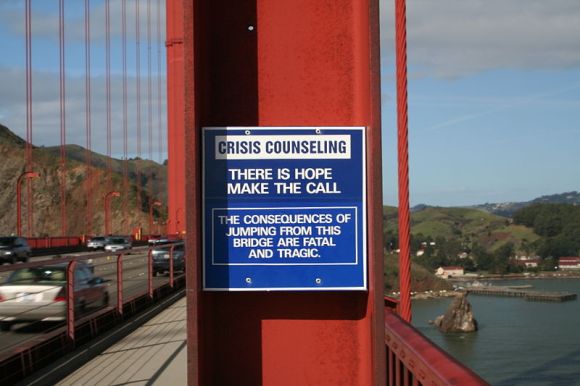
Japan often gets a reputation as a suicide-heavy nation but the social problem of self-destruction is something all parts of the world have to tackle.
The following is a list of five places in the world where suicides have most often occurred. It’s a bittersweet honor in that they are all either places of extreme natural beauty of impressive feats of engineering.
On the other hand, they are also places and countries that clearly do too little to prevent either the mental illness that leads to suicide of the act itself.
5 – Niagara Falls (Canada/USA)
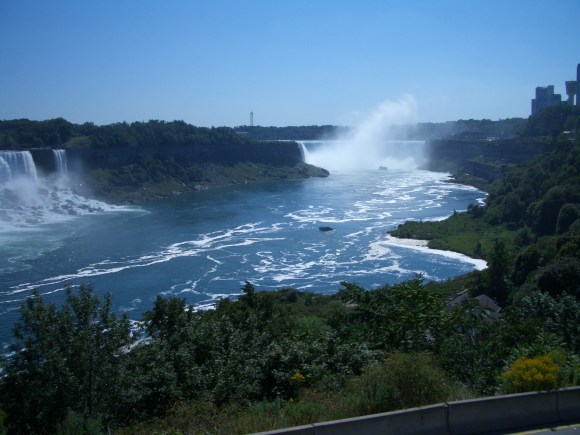
The gorgeous Niagara Falls which straddles the Canadian-US border is often informally referred to as the “honeymoon capital of the world” with its picturesque scenery of lush blue and green. Apparently it’s that same romanticism that drives people to jump over the rocky edges into the fiercely powerful water.
A local historian claimed that 2,780 known suicides occurred around the falls from 1856 to 1995. Of Niagara Falls jumpers there has been a disproportionately large number of female victims (41%) compared to the rest of America.
4 – The Gap (Australia)
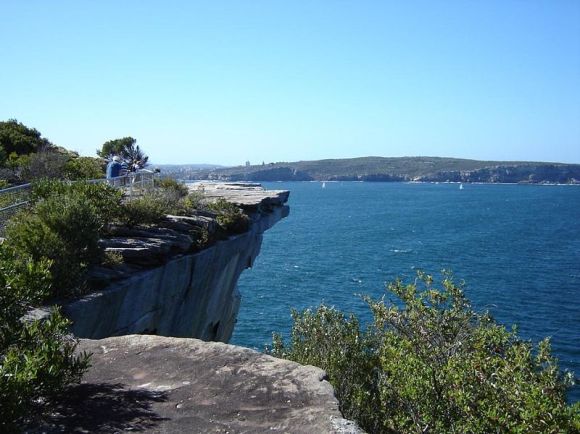
On the other side of the world it’s the same story. The beautiful cliffs of The Gap on South Head peninsula are part of a pleasant sightseeing spot that draws scores of people. However, an estimated 50 of the visitors per year go there with another agenda.
One bright spot in this is a man named Don Ritchie. Don was a WWII veteran, full-time insurance salesman, and part-time greatest guy who ever lived. Over a span of 45 years he rescued at least 160 people from themselves just by lending them an ear and an occasional beer. Sadly, Mr. Ritchie is no longer with us but he lives on as an inspiration of how easy it can be to change people’s lives for the better.
3 – Golden Gate Bridge (USA)
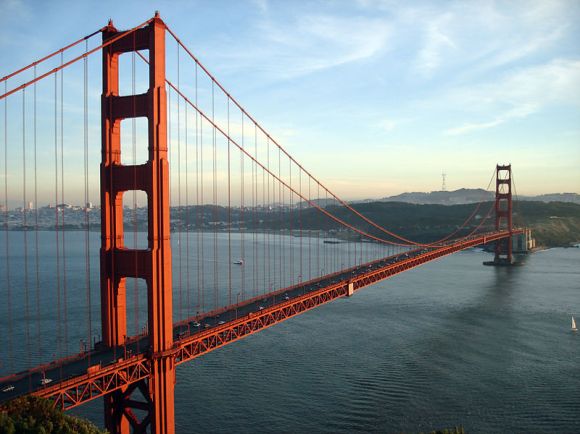
What really needs to be said about the Golden Gate Bridge? It’s viewed by tourists from around the world daily and is considered to be one of (if not the) most beautiful bridges in the world. I can’t help thinking about the beginning of Full House when I see it, but that’s my own issue.
Its other reputation was the subject of a 2006 documentary The Bridge. The movie references two jumping survivors, Ken Baldwin and Kevin Hines who both admitted to changing their minds only after making their potentially fatal jump.
As of 2005, the official suicide count was over 1,200. Very few efforts have been made to erect a fence reportedly due to budget and aesthetic concerns.
2 – Nanjing Yangtze River Bridge (China)
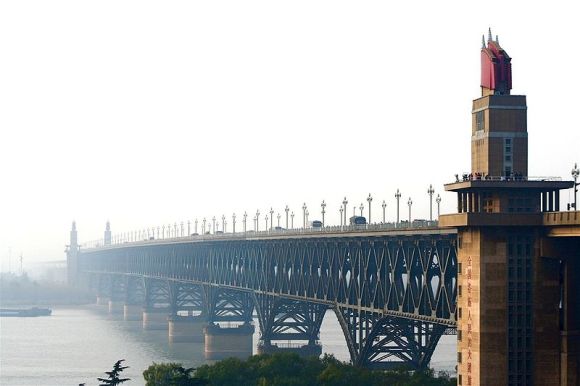
The Nanjing Yangtze River Bridge was a major achievement for the then recently in-power People’s Republic of China. Built entirely by the might of the nation it was the first industrial strength bridge of its kind there. When completed in 1968, it provided a much needed transportation link between Beijing and Shanghai.
Since then it has also attracted over 2,000 jumpers. This is considered to be a gross underestimate though and little effort from the government has been made to deter suicides.
And yet another heroic local named Chen Si has taken it upon himself to help out. If you’re ever around the bridge on a weekend you’ll probably see him with a baseball cap and pair of binoculars on patrol during his off time and saving over 100 lives (possibly 200 by now). However, if you’re planning to do something rash on the Nanjing Yangtze River Bridge, he’ll find you.
1 – Aokigahara Forest (Japan)
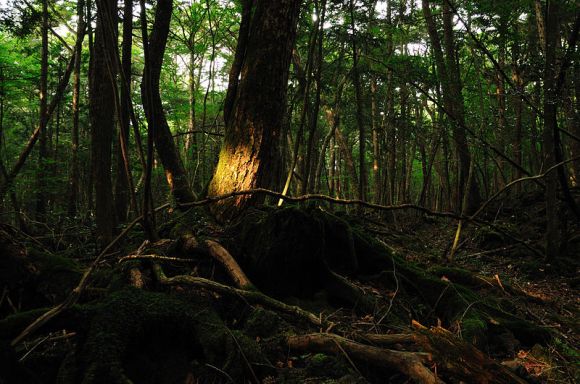
Also known as the “Sea of Trees” this sprawling forest rests at the foot of Mount Fuji.
Its reputations as a place of mystery and a location for suicide have fueled each other over the years snowballing into what is possibly the most active place for suicides in the world.
Much of the mystical reputation of Aokigahara may come from the old saying “once you set foot in Aokigahara you don’t come out.” However, this was probably referring to the very rough terrain of the deep forest carved out by volcanic activity.
Nevertheless, urban legends surrounding the area endure. Some believe that compasses or GPS can’t function which any soldier in training can tell you is false (aside from GPS being affected by the tree cover).
There is also a belief that digital clocks go haywire when passing through or near the forest – a claim that has about as much validity as saying Candyman in the mirror three times.
The number of suicides in Aokigahara tends to spike during times when film or television adaptations of a popular novel that deals with suicide and this forest Tower of Waves (Nami no To) are released. This is probably more due to heightened media attention than an actual rise in suicides though.
The real cause of Aokigahara and Japan’s large number of suicides is likely connected to the lingering stigma attached to mental illness which dissuades many from getting their needed treatment.
■
In the end, these rankings cannot be considered accurate because it’s impossible to accurately count the number of suicides that take place 24/7 and the top three especially could be completely reversed. It’s not the statistics that are important anyway.
We could point the finger at the places themselves for not setting-up the proper equipment or blame governments for not having adequate mental health programs for all.
Or, instead of waiting for someone else to do it, we could take the examples set by Chen Si and Don Ritchie and do something about it ourselves – starting with the people closest to you.
Source: Karapaia (Japanese)
Top Image: Wikipedia – David Corby
Aokigahara Video: YouTube – JGSD Fomega
Chen Si Video: YouTube: 冬烨 马
Don Ritchie Video: YouTube –CommBank
▼ Video showing some of a regular corpse patrol of Aokigahara. Images may be disturbing.
▼ Interview with Chen Si. Images may be inspiring.
▼ Short interview with Don Ritchie shortly before his passing.

 2014 suicide rates in Japan down, suicide in men still twice that of women
2014 suicide rates in Japan down, suicide in men still twice that of women Japan’s beautiful “suicide forest” sees increase in sightseers as it tries to shake its dark image
Japan’s beautiful “suicide forest” sees increase in sightseers as it tries to shake its dark image Japanese Twitter reacts to Logan Paul’s “Japanese Suicide Forest” video
Japanese Twitter reacts to Logan Paul’s “Japanese Suicide Forest” video Unexpected Japan suicide facts are equal parts depressing and uplifting
Unexpected Japan suicide facts are equal parts depressing and uplifting Japanese YouTuber joins calls to delete Logan Paul’s YouTube account 【Video】
Japanese YouTuber joins calls to delete Logan Paul’s YouTube account 【Video】 Japan’s new difficult-to-drink-from beer glass protects your liver, but it’s a brutal experience
Japan’s new difficult-to-drink-from beer glass protects your liver, but it’s a brutal experience How to order snacks on a Shinkansen bullet train in Japan
How to order snacks on a Shinkansen bullet train in Japan New Pokémon ice cream, dessert drinks, and cool merch coming to Baskin-Robbins Japan【Pics】
New Pokémon ice cream, dessert drinks, and cool merch coming to Baskin-Robbins Japan【Pics】 Demon Slayer: Kimetsu no Yaiba gets new roller coaster attractions and food at Universal Studios Japan
Demon Slayer: Kimetsu no Yaiba gets new roller coaster attractions and food at Universal Studios Japan Caffeinated ramen for gamers that you can eat with one hand going on sale in Japan
Caffeinated ramen for gamers that you can eat with one hand going on sale in Japan Burger King Japan suddenly adds Dr. Pepper and Dr. Pepper floats to its menu nationwide
Burger King Japan suddenly adds Dr. Pepper and Dr. Pepper floats to its menu nationwide “The most Delicious Cup Noodle in history” – Japan’s French Cup Noodle wins our heart【Taste test】
“The most Delicious Cup Noodle in history” – Japan’s French Cup Noodle wins our heart【Taste test】 New samurai glasses are Japan’s latest weird must-have souvenir
New samurai glasses are Japan’s latest weird must-have souvenir Doraemon found buried at sea as scene from 1993 anime becomes real life【Photos】
Doraemon found buried at sea as scene from 1993 anime becomes real life【Photos】 Hello, cosmetics! Clinique teams up with Hello Kitty this summer for first-time collaboration
Hello, cosmetics! Clinique teams up with Hello Kitty this summer for first-time collaboration Nintendo history you can feel – Super NES, N64, and GameCube controllers become capsule toys
Nintendo history you can feel – Super NES, N64, and GameCube controllers become capsule toys Starbucks releases a cute Frappuccino and Unicorn Cake…but not in Japan
Starbucks releases a cute Frappuccino and Unicorn Cake…but not in Japan Kyoto Tower mascot termination reveals dark side behind cute Japanese characters
Kyoto Tower mascot termination reveals dark side behind cute Japanese characters McDonald’s Japan’s Soft Twist Tower: A phantom ice cream only sold at select branches
McDonald’s Japan’s Soft Twist Tower: A phantom ice cream only sold at select branches Yabai Ramen: What makes this Japanese ramen so dangerous?
Yabai Ramen: What makes this Japanese ramen so dangerous? Finally! Nintendo Japan expands Switch 8-bit controller sales to everybody, Online member or not
Finally! Nintendo Japan expands Switch 8-bit controller sales to everybody, Online member or not Japanese government wants to build luxury resorts in all national parks for foreign tourists
Japanese government wants to build luxury resorts in all national parks for foreign tourists To combat declining birth rate, Japan to begin offering “Breeding Visas” to foreigners
To combat declining birth rate, Japan to begin offering “Breeding Visas” to foreigners 10 things you should buy at 7-Eleven in Japan
10 things you should buy at 7-Eleven in Japan Studio Ghibli releases anime heroine cosplay dresses that are super comfy to wear
Studio Ghibli releases anime heroine cosplay dresses that are super comfy to wear Woman charged for driving suitcase without a license in Osaka
Woman charged for driving suitcase without a license in Osaka Studio Ghibli unveils My Neighbour Totoro miniature house model
Studio Ghibli unveils My Neighbour Totoro miniature house model Kyoto experiencing problems with foreign tourists not paying for bus fares, but not on purpose
Kyoto experiencing problems with foreign tourists not paying for bus fares, but not on purpose Fighting mild hunger with a Japanese soda that turns into jelly in the stomach【Taste test】
Fighting mild hunger with a Japanese soda that turns into jelly in the stomach【Taste test】 Studio Ghibli’s Howl’s Moving Castle tapestry unveiled in Japan for first time
Studio Ghibli’s Howl’s Moving Castle tapestry unveiled in Japan for first time McDonald’s new Happy Meals offer up cute and practical Sanrio lifestyle goods
McDonald’s new Happy Meals offer up cute and practical Sanrio lifestyle goods Sales of Japan’s most convenient train ticket/shopping payment cards suspended indefinitely
Sales of Japan’s most convenient train ticket/shopping payment cards suspended indefinitely Sold-out Studio Ghibli desktop humidifiers are back so Totoro can help you through the dry season
Sold-out Studio Ghibli desktop humidifiers are back so Totoro can help you through the dry season Japanese government to make first change to romanization spelling rules since the 1950s
Japanese government to make first change to romanization spelling rules since the 1950s Foreigner’s request for help in Tokyo makes us sad for the state of society
Foreigner’s request for help in Tokyo makes us sad for the state of society Ghibli founders Toshio Suzuki and Hayao Miyazaki contribute to Japanese whisky Totoro label design
Ghibli founders Toshio Suzuki and Hayao Miyazaki contribute to Japanese whisky Totoro label design Tokyo’s most famous Starbucks is closed
Tokyo’s most famous Starbucks is closed Princesses, fruits, and blacksmiths: Study reveals the 30 most unusual family names in Japan
Princesses, fruits, and blacksmiths: Study reveals the 30 most unusual family names in Japan Microsoft pulls game inspired by Logan Paul’s infamous suicide forest video from Xbox Store
Microsoft pulls game inspired by Logan Paul’s infamous suicide forest video from Xbox Store Seoul anti-suicide initiative backfires, deaths increase by more than six times
Seoul anti-suicide initiative backfires, deaths increase by more than six times Heroic bus driver prevents roadside suicide on bridge in China 【Video】
Heroic bus driver prevents roadside suicide on bridge in China 【Video】 Japan’s suicide number drops for eighth straight year, rises among teens
Japan’s suicide number drops for eighth straight year, rises among teens Woman kills self jumping onto train tracks, delay causes conductor to jump off tracks at other station
Woman kills self jumping onto train tracks, delay causes conductor to jump off tracks at other station The number of suicides among Japanese citizens jumped in August, worrying officials
The number of suicides among Japanese citizens jumped in August, worrying officials 16 facts about India that will blow your mind
16 facts about India that will blow your mind Man hangs himself outside of Japan’s busiest train station
Man hangs himself outside of Japan’s busiest train station Terrific Tochigi! Japanese prefecture proves its beauty with scenery showcase【Video】
Terrific Tochigi! Japanese prefecture proves its beauty with scenery showcase【Video】 Mystery in Shinjuku as woman plunges to death on visiting restroom
Mystery in Shinjuku as woman plunges to death on visiting restroom Mystery Tourist Spot: Merlions in Japan?
Mystery Tourist Spot: Merlions in Japan? Rubbernecking gone too far? Net users react to crowds taking pics of train hit by suicide jumper
Rubbernecking gone too far? Net users react to crowds taking pics of train hit by suicide jumper Middle-aged Chinese man’s “stomach pains” turn out to be his first period as a woman
Middle-aged Chinese man’s “stomach pains” turn out to be his first period as a woman Is Pokémon Go helping prevent deaths at one of Japan’s most notorious suicide spots?
Is Pokémon Go helping prevent deaths at one of Japan’s most notorious suicide spots? Kyoto temple bans photography at famous autumn foliage viewing spots
Kyoto temple bans photography at famous autumn foliage viewing spots
Leave a Reply